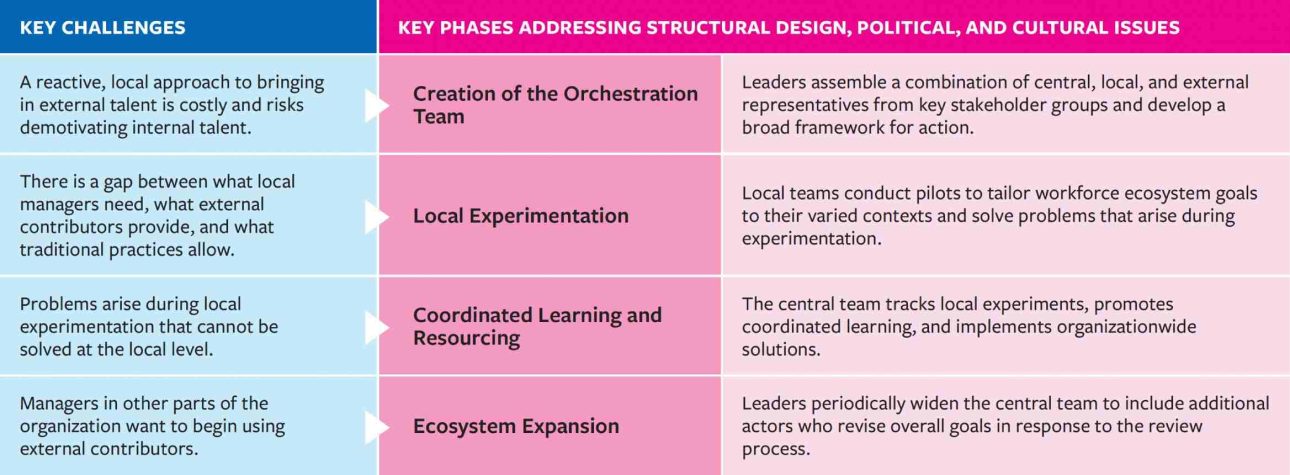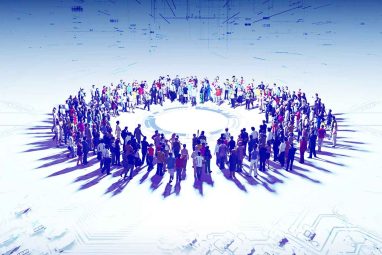Manage Your Workforce Ecosystem, Not Just Your Employees
Skillfully orchestrating a workforce that includes external workers and even technologies requires new organizational structures.
Topics
News
- How Third-Party Data Can Shape Customer Experiences in Financial Industry
- AI, Data, and IoT Dominate Business Priorities
- These Are the Top Challenges of Middle East CEOs
- UAE releases new AI model to compete with big tech
- How AWS, GCP, and Microsoft Azure Serve the Growing Demand for AI Inference
- AI, Regulation, and Digital Transformation Feature Prominently in the NextTech Agenda

“How do you define your workforce?” We have posed this question to dozens of executives and in multiple global management surveys. The most common answer is also the most surprising.
A confident minority of executives say their workforce is just their employees. But the overwhelming majority, especially leaders on the front lines of organizational transformations, takes a broader view that goes beyond just employees. Increasingly, they characterize the workforce as all of the people and groups involved in achieving the company’s business objectives. Organizations’ extended workforces have become so essential to their businesses, brands, and approaches to value creation that they need to think differently about, and act differently toward, their entire workforce.
That represents a shift in management perspective since we began our study of the future of the workforce a few years ago. We are seeing this change across industries and a variety of organizations, large and small — and it is challenging leaders to redefine who and what constitutes their workforce and to develop new management practices and organizational structures.
Hierarchical, command-and-control, internally focused management practices are ill suited for workforces that span internal and external organizational boundaries. Using siloed functions to independently manage employees and external contributors, for example, is fraught with challenges: Ill-defined decision rights, governance processes, and power dynamics can undermine even the most well-intentioned executives. In addition, the technology systems for managing employees are typically different and disconnected from those for accessing and tracking external contributors. This lack of integration creates inefficiencies that can thwart efforts to obtain and maintain strategically valuable capabilities.
We define workforce ecosystem as a structure that encompasses actors, from within the organization and beyond, working to create value for an organization. Within the ecosystem, actors work toward individual and collective goals with interdependencies and complementarities among the participants.
Workforce ecosystems include employees as well as external contributors and partners of various kinds — long- and short-term contractors, gig workers, application developers, service providers, and crowdsourced actors. An ecosystem perspective explicitly recognizes that accessing and engaging workforces is no longer the sole purview of the human resources function but requires cross-functional actions involving leaders in the C-suite, IT, procurement, finance, legal, and other areas.
Intentionally orchestrating a workforce ecosystem requires leaders to coordinate activities across their own organization and with external contributors. To meet this challenge, companies need to reassess coordination between functions such as human resources, procurement, and IT. Decisions also need to made about how to govern relationships with external contributors, such as application developers and subcontractors. We developed the concept of integration architectures to define both that internal coordination and how organizations interact with their extended workforce.
Our integration architecture model contrasts with the default, siloed approach to managing interactions in most workforce ecosystems. Typically, contingent workers are the responsibility of procurement. Partners and alliances are often handled by strategy, and AI and automation are part of the tech organization (but rarely regarded as part of the broader workforce ecosystem). HR typically oversees full- and part-time employees. In this common approach, multiple groups work independently to govern the contributors for which they have a mandate, but efforts across the organization are uncoordinated.
Orchestrating a workforce ecosystem requires leaders to coordinate activities across their own organization and with external contributors.
Managers in different departments frequently use combinations of external and internal workers without any centralized coordination. These decentralized approaches may be efficient on a local level, where each business unit and functional manager retains maximum control, but they are suboptimal at an aggregate level.
Indeed, decentralization can have substantial drawbacks when orchestrating a workforce ecosystem. Dispersed efforts may not be aligned with overall strategic priorities and may undermine a business’s pursuit of new strategic directions. The lack of integration may limit available data about who (and what) is contributing to an organization. It may lead to cost inefficiencies as contingent workers are sourced on an ad hoc basis. And it likely means that both internal workers and external contributors (existing and potential) have less visibility into opportunities to contribute. While decentralization is currently the most common approach to managing employees and the extended workforce, it is almost always uncoordinated.
Why Centralized Integration Architectures Appeal
Given the shortcomings of decentralized architectures, many organizations orchestrating workforce ecosystems are creating integration architectures that are more centralized and cross-functional in their design. In some organizations, HR coordinates workforce ecosystem management with the procurement and IT functions; in these cases, business leaders and teams work with HR and others to proactively manage risks. Other companies are adopting a more cross-functional approach to managing all types of individual workers and providers; in these cases, HR plays a key but less central role, with talent marketplaces playing a more prominent role in supporting workforce needs across business units and functions.
Swiss global health care company Novartis, for example, has set up a cross-functional steering committee to manage its approximately 100,000 internal workers and roughly 50,000 external ones. Novartis is working to provide managers with visibility into internal and external talent sources, an effort driven by data culled from a variety of partners and platforms. The process will be facilitated by curators called workforce strategists, who will grant managers real-time access to teams of employees, contractors, and technologies.
The pandemic prompted HR at another global company we studied to get more involved with overseeing the broader workforce because of the concerns it raised about remote and onsite work policies, pay continuity, absences, and sick leave for both contingent workers and employees. Before the pandemic, HR paid close attention only to what was going on with full-time-equivalent or part-time employees, the company’s vice president of HR reported; often, with contingent workers, “HR was not in the loop at all,” she said. At that time, there wasn’t even a shared understanding of who comprises the company’s contingent workforce. The pandemic lent urgency to the idea that the company would have to be more centrally integrated and agile to take care of its contingent workers. It also underscored that the company needed to better manage the reputational, legal, operational, and cost risks of the broader workforce, and to use the entire workforce to its fullest competitive advantage.
At this same company, hiring processes and procedures had historically differed by department — and departments tended not to communicate with one another. HR supported decisions about hiring permanent employees, while procurement brought in contingent workers. Meanwhile, unbeknownst to HR, managers were often converting contingent workers into full-time employees. A newly developed clearinghouse platform that involved HR, procurement, and finance gave the company data-based cross-functional visibility into tracking and approving external workers.
Management of the contingent workforce had been a hot potato at the company, according to the chief procurement officer: “Anybody who was at the center was on the hook for all the risk and none of the benefit.” But he described the company as having shifted to thinking of its relationship with contingent workers in strategic rather than transactional terms, which involves managing the contingent workforce cross-functionally. As the vice president of HR explained, “There was an acknowledgment between our CFO, our chief general counsel, our CHRO [chief human resources officer], and our chief operating officer that they all had skin in the game.”
Talent marketplaces are another great tool for anchoring a centralized and more cross-functionally integrated architecture. NASA, for example, used to have six talent-market platforms spread across multiple units, each of which independently matched employees with gigs and projects. Now the space agency uses a single talent marketplace — one orchestrating mechanism — to coordinate access to internal human talent across the organization. Extending its internal talent marketplace to external contributors is on NASA’s horizon.
Integration Architecture Challenges
While centralized and cross-functional integration architectures are enabling organizations to achieve higher levels of coordination in their workforce ecosystems, these efforts are in their nascent stages. Even among companies on the leading edge of workforce ecosystem transformations, leaders emphasize that these efforts are just starting to gain traction. In our research and consulting work, we see that most organizations still take reactive, local, and uncoordinated approaches to enlisting and retaining external talent and complementary contributors.
Leaders realize that such decentralized efforts are both cost- and resource-inefficient and risk demotivating internal employees. Yet they struggle to establish a centralized cross-functionally integrated architecture for workforce ecosystem orchestration. We have heard the following concerns:
- How do you identify the right set of stakeholders to create a centrally integrated architecture for workforce ecosystem orchestration?
- How do you get stakeholders to engage in local workforce ecosystem experiments to tailor shared goals to specific contexts?
- How do you promote coordinated learning from local experimentation?
- How do you improve your workforce ecosystem implementation process over time?
To create an integrated workforce ecosystem, at least three types of issues need to be addressed: structural design (pertaining to the division of labor, goals, and incentives), politics (relating to resources, power, and status), and culture (affecting individuals’ search for identity and meaning). We recommend taking a phased approach to these issues, which intertwine, overlap, and can reinforce one another. This process is likely to be most appropriate for large, established organizations that are starting to embrace workforce ecosystems, but key elements should be helpful for those in small and medium-size enterprises. (See “Four Phases of Orchestrating an Integrated Workforce Ecosystem.”)
Four Phases of Orchestrating an Integrated Workforce Ecosystem

The graphic describes the key challenges associated with orchestrating workforce ecosystems and the phases associated with addressing them.
In the first phase, we propose creating an orchestration team to develop a working plan, goals, and metrics in consultation with relevant local and central stakeholders, both internal and external. This team should focus on integration considerations within the organization (functional roles and responsibilities) and on relationships with external participants. By working with groups within the organization that already engage external workers, the team can get a head start with managers experienced in orchestrating parts of workforce ecosystems. From a structural design perspective, they can quickly begin to highlight and address previously identified skills gaps.
To deal with political concerns, the team can choose local well-respected and action-oriented champions to lead transformations. Additionally, the team can include representatives from external contributors to bring their perspectives to the efforts. Team members should be able to speak for functional areas, product groups, and business units as appropriate; the key is to obtain participation from across stakeholder groups. Finally, to grapple with cultural challenges, at least one team member should play the role of a boundary spanner, serving as a go-between among the central team, local teams, and other affected groups.
In the second phase, we suggest promoting local experimentation. Central orchestration teams can introduce pilot programs to explore potential configurations of workforce ecosystem relationships. These experiments can address structural issues, such as staffing projects with a mix of internal and external workers, identifying necessary skills, ensuring competencies, and measuring the quality of outcomes. They can address political challenges, such as internal employees resisting contributions from external workers and local leaders feeling tension as they lose some control over team composition. Finally, cultural questions may arise as employees adapt to shifts in responsibilities, especially if they need to take on more of a facilitation role coordinating participants from various sources.
In the third phase, we emphasize coordinated learning and resourcing, which spans challenges (and successes) identified by local teams and overseen by the central team. Structural impediments, such as existing policies and procedures (intellectual property licensing models or training rules, for example) may serve the organization well in a traditional employee life-cycle model but require revision for a workforce ecosystem. Resourcing issues may arise as local managers hire more external workers or partner more easily with subcontractors but then refuse to release employees to accept other opportunities. Even when the C-suite and lower levels embrace changes, midtier managers might be resistant because they are often tasked with managing the day-to-day challenges of these sometimes highly disruptive transformations.
In the fourth and final phase, we consider workforce ecosystem expansion. Once initial pilots are analyzed and new practices are starting to be institutionalized, leaders should consider what other new systems, tools, goals, metrics, and processes have proved successful enough to adopt. These should be regularly reviewed as the organization continues to gain knowledge and experience. Leaders may want to expand the central orchestration team to include representation from other internal groups. And they may want to consider connecting their workforce ecosystems with others — for example, working more closely with client organizations and their ecosystems. Culturally, leaders may consider more actively promoting distributed learning and workforce ecosystem activities through storytelling and other communication tools. They will likely want to highlight growth opportunities while also beginning to address the myriad concerns that inevitably accompany such transformations.
This four-phase approach offers a practical way to engage, connect, and activate key stakeholders. From there, organizations can begin to shape their own strategies and pathways by experimenting with new types of integration architectures and quickly iterating as they learn what does and doesn’t work across different contexts.
Echoing the way that integration architectures define how internal functions and business units work together to orchestrate workforce ecosystems, leaders need to define how to govern relationships with external contributors. Leaders face several decisions about which integration architectures are appropriate for external contributors.
The choice of third-party integration architectures may determine the degree to which partners are willing to expend resources to participate in (or contribute to) the workforce ecosystem. Decisions around how to coordinate with developer ecosystems, for instance, can be critical to effective workforce ecosystems. Google Play is Google’s distribution marketplace for apps and content. In comparison to Apple’s App Store, through which Apple distributes apps and content, Google has a lighter touch, with less-strict requirements and compliance testing. Apple’s policies are known to be much more stringent. Integration architectures with external developers may have more or less rigidity and be more or less welcoming.
Crafting integration architectures with third parties raises questions about who should own these relationships within the enterprise. For example, video game console manufacturers often enable third-party developers (complementors) to create games that work on their systems; frequently, it is the demand for these third-party games that drives sales of particular consoles. Should developer relations be the responsibility of a business development or strategy group (that may also handle strategic alliances) or a separate group with specific responsibilities for developer ecosystems? An integration architecture helps define responsibilities and adjudicate potential conflicts among internal groups with competing interests.
Implementing integration architectures in your organization begins with an assessment of how your workforce ecosystem currently functions. How much visibility and control does your organization’s HR function currently have over internal and external contributors? If these contributors are currently managed in a decentralized manner, evaluate whether your organization is best served by this architecture.
If you recognize that a more centrally integrated and orchestrated workforce ecosystem would be a better approach for your organization, decide which groups and individuals should be part of the orchestration team. Should someone (or some group) be centrally responsible for overseeing the entire workforce ecosystem?
Throughout our research, we have heard leaders describe their struggles to engage talent essential to their company’s success within an increasingly complex and connected workforce ecosystem. We have observed time and again that intentionally orchestrating a workforce ecosystem perspective can help leaders take a much richer and more nuanced view of their own organization and the people, partners, and technologies upon which they rely to meet their strategic goals and objectives.





